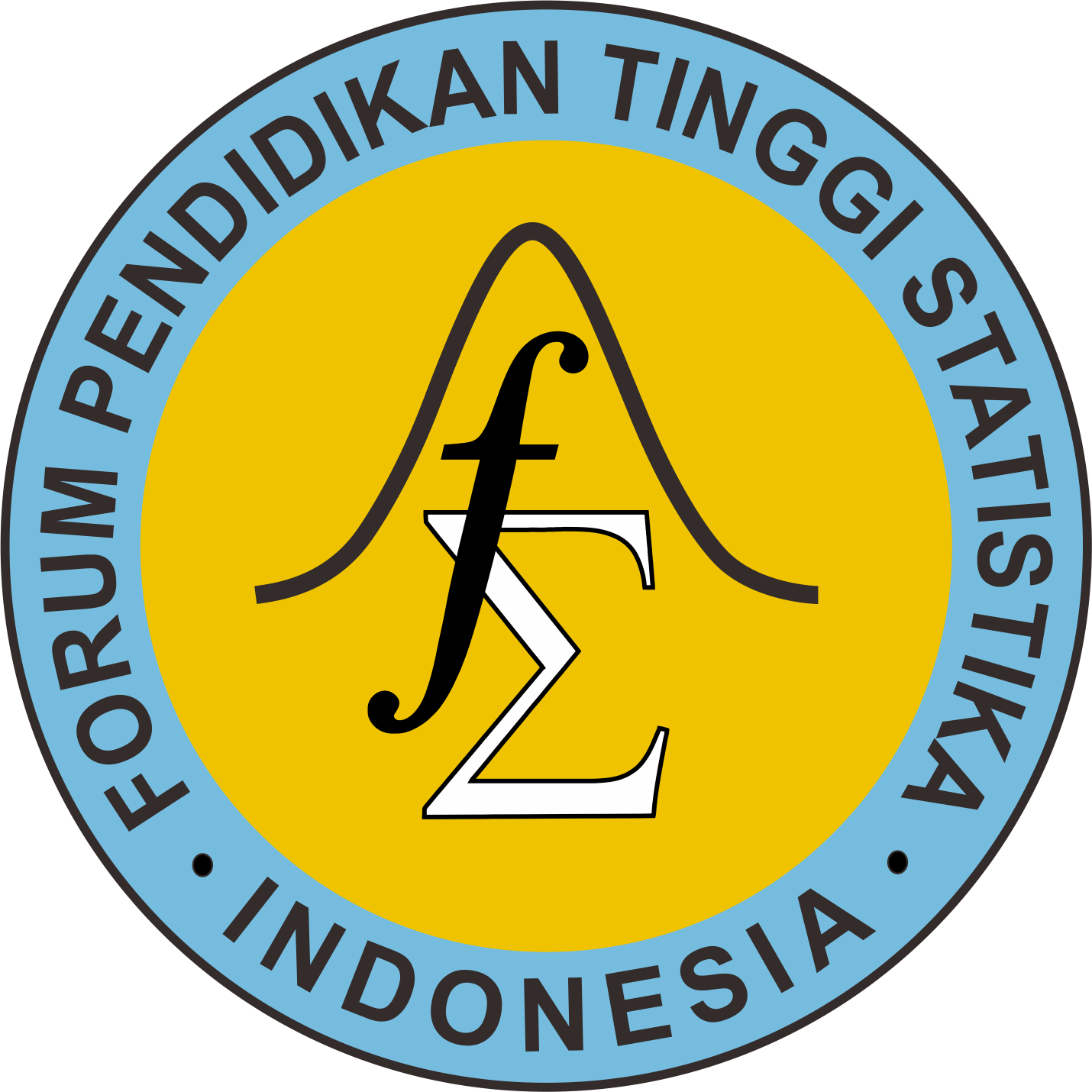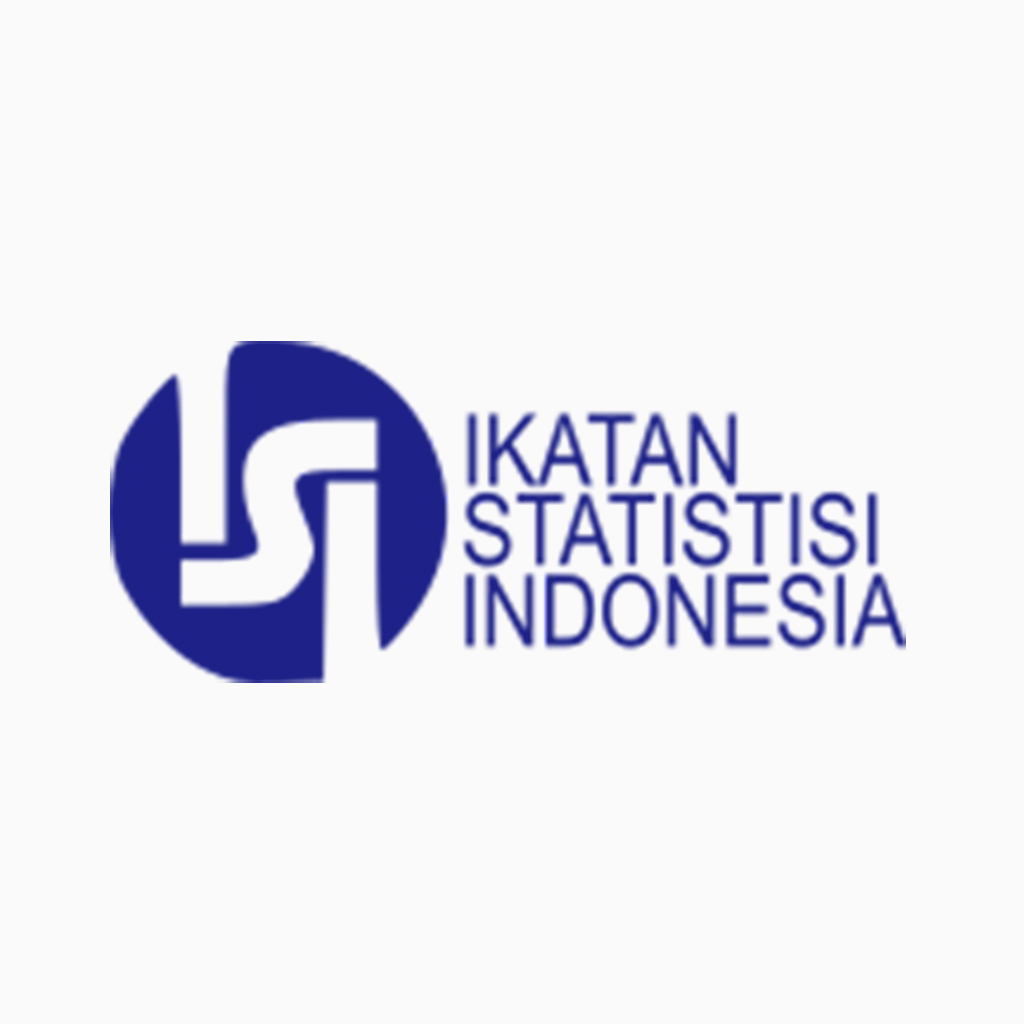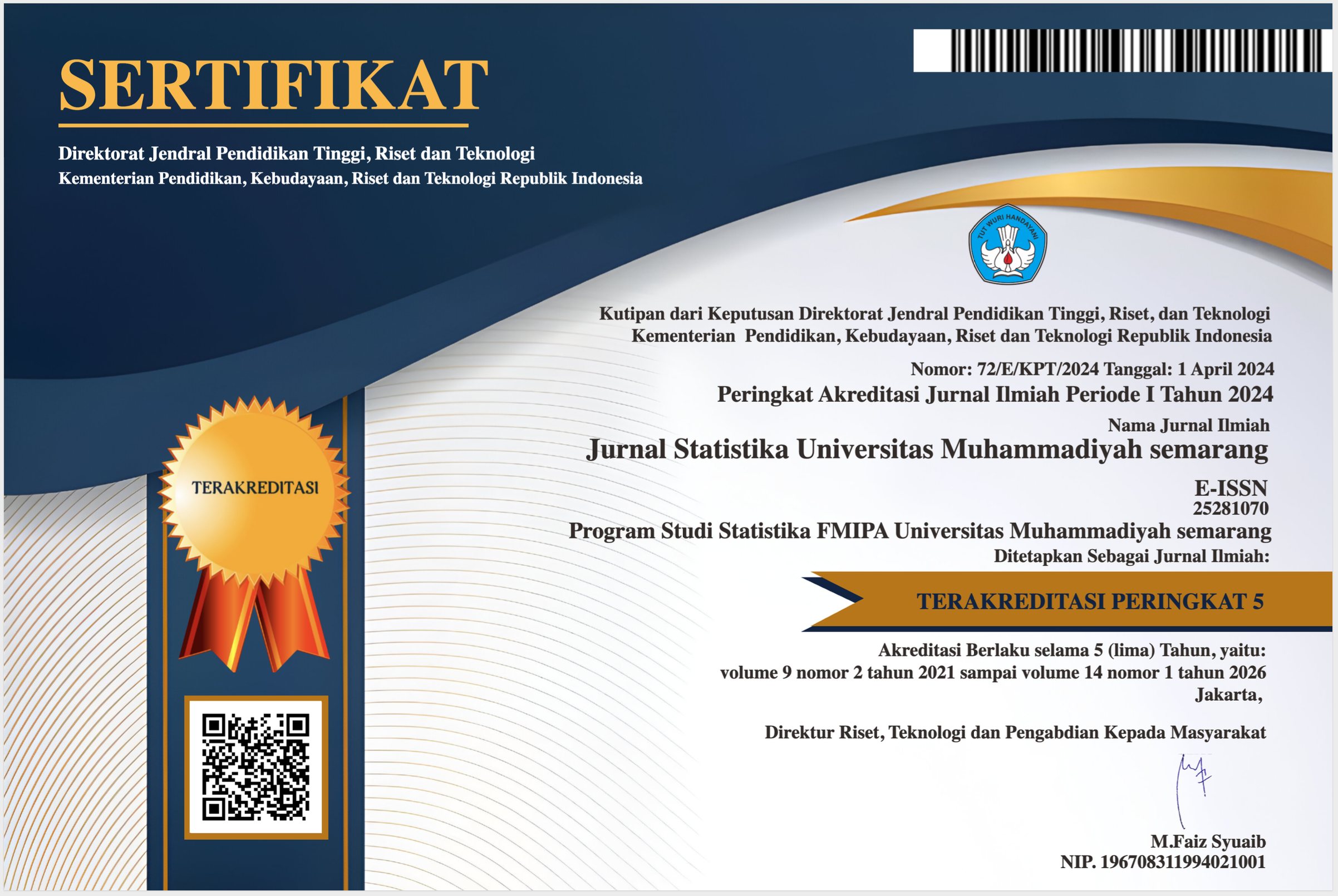ORDINAL XGBOOST FOR MULTICLASS NUTRITIONAL STATUS CLASSIFICATION WITH IMBALANCED DATA
(1) Department of Mathematics Education, Universitas Negeri Yogyakarta, Indonesia
(2) Department of Mathematics, Universitas Jenderal Soedirman, Indonesia
(*) Corresponding Author
Abstract
Keywords
Full Text:
PDFReferences
T. T. Tamir, S. A. Gezhegn, D. T. Dagnew, A. T. Mekonenne, G. T. Aweke, and A. M. Lakew, “Prevalence of childhood stunting and determinants in low and lower-middle income African countries: Evidence from standard demographic and health survey,” PLoS One, vol. 19, no. 4, p. e0302212, Apr. 2024, doi: 10.1371/journal.pone.0302212.
A. J. Prendergast and J. H. Humphrey, “The stunting syndrome in developing countries,” Paediatr Int Child Health, vol. 34, no. 4, pp. 250–265, Nov. 2014, doi: 10.1179/2046905514Y.0000000158.
Y. Anggraini and N. F. Romadona, “Review of Stunting in Indonesia,” in Proceedings of the International Conference on Early Childhood Education and Parenting 2019 (ECEP 2019), Paris, France: Atlantis Press, 2020. doi: 10.2991/assehr.k.200808.055.
R. R. Akbar, W. Kartika, and M. Khairunnisa, “The Effect of Stunting on Child Growth and Development,” Scientific Journal, vol. 2, no. 4, pp. 153–160, Jul. 2023, doi: 10.56260/sciena.v2i4.118.
P. Ssentongo et al., “Global, regional and national epidemiology and prevalence of child stunting, wasting and underweight in low- and middle-income countries, 2006–2018,” Sci Rep, vol. 11, no. 1, p. 5204, Mar. 2021, doi: 10.1038/s41598-021-84302-w.
Sheik Mohamed S. H., “CHILD NUTRITION AND GROWTH MONITORING IN MOLDOVA: CHALLENGES AND INTERVENTIONS,” JTH: Journal of Technology and Health, vol. 2, no. 4, pp. 187–195, May 2025, doi: 10.61677/jth.v2i4.161.
M. de Onis and F. Branca, “Childhood stunting: a global perspective,” Matern Child Nutr, vol. 12, no. S1, pp. 12–26, May 2016, doi: 10.1111/mcn.12231.
B. Soetono and A. S. Barokah, “Trends in Stunting Prevalence Reduction: an Examination of Data Toward Achieving the 2024 Target in Indonesia,” Article The Social Perspective Journal, vol. 3, no. 1, pp. 51–68, 2024, doi: 10.53947/tspj.v3i1.795.
FAO, IFAD, UNICEF, WFP, and WHO, The State of Food Security and Nutrition in the World 2024 – Financing to end hunger, food insecurity and malnutrition in all its forms. Rome: FAO; IFAD; UNICEF; WFP; WHO;, 2024. doi: 10.4060/cd1254en.
United Nations Children’s Fund, “Joint child malnutrition estimates,” Who. Accessed: Jul. 07, 2025. [Online]. Available: https://data.unicef.org/resources/levels-and-trends-in-child-malnutrition-2018/%0Awww.who.int/nutgrowthdb/estimates%0Ahttps://www.who.int/data/gho/data/themes/topics/joint-child-malnutrition-estimates-unicef-who-wb
G. Aguiar, B. Krawczyk, and A. Cano, “A survey on learning from imbalanced data streams: taxonomy, challenges, empirical study, and reproducible experimental framework,” Mach Learn, vol. 113, no. 7, pp. 4165–4243, Jul. 2024, doi: 10.1007/s10994-023-06353-6.
K. De Angeli et al., “Class imbalance in out-of-distribution datasets: Improving the robustness of the TextCNN for the classification of rare cancer types,” J Biomed Inform, vol. 125, p. 103957, Jan. 2022, doi: 10.1016/j.jbi.2021.103957.
A. Fernández, S. García, M. Galar, R. C. Prati, B. Krawczyk, and F. Herrera, Learning from Imbalanced Data Sets. Cham: Springer International Publishing, 2018. doi: 10.1007/978-3-319-98074-4.
J. L. Leevy, T. M. Khoshgoftaar, R. A. Bauder, and N. Seliya, “A survey on addressing high-class imbalance in big data,” J Big Data, vol. 5, no. 1, p. 42, Dec. 2018, doi: 10.1186/s40537-018-0151-6.
T. L. Nxumalo, R. M. Rimiru, and V. M. Magagula, “A Deep Learning Ordinal Classifier,” International Journal of Advanced Computer Science and Applications, vol. 16, no. 3, 2025, doi: 10.14569/IJACSA.2025.0160330.
E. Frank and M. Hall, “A Simple Approach to Ordinal Classification,” 2001, pp. 145–156. doi: 10.1007/3-540-44795-4_13.
F. Kahl, I. Kahl, and S. M. Jonas, “XGBOrdinal: An XGBoost Extension for Ordinal Data,” in Stud Health Technol Inform, 2025, pp. 462–466. doi: 10.3233/SHTI250380.
L. Ruisen et al., “Bagging of Xgboost Classifiers with Random Under-sampling and Tomek Link for Noisy Label-imbalanced Data,” IOP Conf Ser Mater Sci Eng, vol. 428, p. 012004, Oct. 2018, doi: 10.1088/1757-899X/428/1/012004.
C. Wang, C. Deng, and S. Wang, “Imbalance-XGBoost: leveraging weighted and focal losses for binary label-imbalanced classification with XGBoost,” Pattern Recognit Lett, vol. 136, pp. 190–197, Aug. 2020, doi: 10.1016/j.patrec.2020.05.035.
A. Agresti, “Analysis of Ordinal Categorical Data - Examples of Using R for Modeling Ordinal Data Summary of R ( and S-Plus ),” Analysis, 2010.
P. McCullagh, “Regression Models for Ordinal Data,” J R Stat Soc Series B Stat Methodol, 1980, doi: 10.1111/j.2517-6161.1980.tb01109.x.
P. A. Gutiérrez and S. García, “Current prospects on ordinal and monotonic classification,” Progress in Artificial Intelligence, 2016, doi: 10.1007/s13748-016-0088-y.
H. He and E. A. Garcia, “Learning from imbalanced data,” IEEE Trans Knowl Data Eng, 2009, doi: 10.1109/TKDE.2008.239.
J. S. Cardoso and R. Sousa, “Measuring the performance of ordinal classification,” Intern J Pattern Recognit Artif Intell, 2011, doi: 10.1142/S0218001411009093.
T. Chen and C. Guestrin, “XGBoost: A scalable tree boosting system,” in Proceedings of the ACM SIGKDD International Conference on Knowledge Discovery and Data Mining, 2016. doi: 10.1145/2939672.2939785.
S. Baccianella, A. Esuli, and F. Sebastiani, “Evaluation measures for ordinal regression,” in ISDA 2009 - 9th International Conference on Intelligent Systems Design and Applications, 2009. doi: 10.1109/ISDA.2009.230.
J. Cohen, “Weighted kappa: Nominal scale agreement provision for scaled disagreement or partial credit,” Psychol Bull, 1968, doi: 10.1037/h0026256.
A. Ben-David, “Comparison of classification accuracy using Cohen’s Weighted Kappa,” Expert Syst Appl, 2008, doi: 10.1016/j.eswa.2006.10.022.
J. de la Torre, D. Puig, and A. Valls, “Weighted kappa loss function for multi-class classification of ordinal data in deep learning,” Pattern Recognit Lett, 2018, doi: 10.1016/j.patrec.2017.05.018.
A. Zhang, H. Hirai, M. Matsumaru, and H. Katagiri, “Corporate Rating Model using Threshold Optimization and XGBoost,” in International Conference on Industrial & Mechanical Engineering and Operations Management, Dhaka, Bangladesh, 2020.
M. Sokolova and G. Lapalme, “A systematic analysis of performance measures for classification tasks,” Inf Process Manag, 2009, doi: 10.1016/j.ipm.2009.03.002.
J. Brownlee, “Calculate Precision, Recall, and F-Measure for Imbalanced Classification,” Inf Process Manag, 2020.
A. A. R. Fernandes and Solimun, “Menelisik Faktor-Faktor Penyebab Stunting pada Anak di Kecamatan Wajak: Integrasi Cluster dengan Path Analysis dengan Pendekatan Statistika dan Sains Data,” 2023.
H. Zhu et al., “Convolutional Ordinal Regression Forest for Image Ordinal Estimation,” IEEE Trans Neural Netw Learn Syst, 2022, doi: 10.1109/TNNLS.2021.3055816.
W. Li, X. Huang, J. Lu, J. Feng, and J. Zhou, “Learning probabilistic ordinal embeddings for uncertainty-aware regression,” in Proceedings of the IEEE Computer Society Conference on Computer Vision and Pattern Recognition, 2021. doi: 10.1109/CVPR46437.2021.01368.
J. R. Landis and G. G. Koch, “An Application of Hierarchical Kappa-type Statistics in the Assessment of Majority Agreement among Multiple Observers,” Biometrics, 1977, doi: 10.2307/2529786.
Article Metrics
Abstract view : 105 timesPDF - 48 times
DOI: https://doi.org/10.26714/jsunimus.13.1.2025.45-60
Refbacks
- There are currently no refbacks.
Copyright (c) 2025 Jurnal Statistika Universitas Muhammadiyah Semarang
Editorial Office:
Department of Statistics
Faculty Of Mathematics And Natural Sciences
Universitas Muhammadiyah Semarang
Jl. Kedungmundu No. 18 Semarang Indonesia
Published by:
Department of Statistics Universitas Muhammadiyah Semarang
This work is licensed under a Creative Commons Attribution 4.0 International License








2.png)



